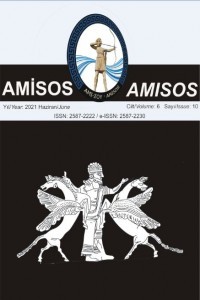RITUAL-WORSHIPPING SCENES AND ARCHITECTURAL IMAGES IN THE ICONOGRAPHY OF URARTIAN BELTS
The following article titled “Ritual-Worshipping Scenes and Architectural Images in the Iconography of Urartian Belts” is a continuation of articles in series of monographic writings wholesomely devoted to detailed research of iconographical content of Urartian bronze belts, including the fundamental creative-constructive components and indispensable composite parts, thematical content, narrative scenes, realistic traditional reflections and mythological symbolism of iconographical images. The main thematic focus of this article is the detailed research of Urartian Ritual-Worshipping Belts, especially in the context of determining their content according to the imagery of ritual-worshipping and ceremonial-religious scenes, and architectural landscapes. The task of research included the finding of main bibliographical sources containing relevant images, data and explanatory statements about Urartian ritual-worshipping belts; creating a database of this particular belt types according to sources of publications and places of safekeeping, whether big or small museums or private collections; identification of main themes, narratives and scenery contents; assessment of the overall design and ways of fastening of those belt types; assessing the overall geometrical proportions of those belt types and the implications of the “narrowness” that resulted in their conditional definition as of Narrow Belts; classification and typological assessment of their main and secondary iconographic elements, including various human characters, different sacral objects of individual or collective use; special sacral objects of worship such as single or multiple layered Moon-Crescents and Sun-Disks; diverse human activities and occupations; various scenes of architectural landscapes, castles, fortifications and their details; images of common animals found only in this belt type; images of only imaginary animal type (fish) of Urartian belts; images of mythological (composite) winged beasts made of animal and abstract parts; images of mythological (composite) creatures made of animal, abstract and human parts, as well as attributes of religious-mythological fashion; images of some other elements, not typical, but sometimes found in the iconography of ritual-worshipping belts, such as symbols of Sacred Tree and Winged Sun-Disk; images of musicians and dancers; images of various musical instruments; images of religious acts such as performing rituals ceremonies, libation, praying, worshipping and making wishes to souls of the deceased, spirits of real animal, mythological beasts and creatures, souls of divinities and gods. The key formula of the transfer of the urartian material culture into urartian spiritual culture is contended, affirmed on a base of the iconographical contexts and thematic narrative contents of the ritual-worshipped belts; as well as validated through law-governed principles of urartian traditional-religious approaches and major mythological-philosophical concepts that was a base of urartian mindset of symbolical meaningfulness. At the end of the article some hints about the possible nature of urartian artistic conceptuality is given in the context of the crucial role that the urartian culture played in the overall process of urartian nation’s formation. Finally, the overall significance of ritual-worshipping belts is assessed in the fundamental framework of Urartian bronze belts studies, and also the possible effects are predicted on how these newer, informatively significant implications of those scientific archeologic-historic inquiries could progressively and positively contribute to Urartological Studies or Urartology.
Anahtar Kelimeler:
Urartian, belts, ritual, worshipping, scene, architectural, image, iconography, tradition, culture
___
- Batmaz, A., Uhri, A. 2008 Urartu Kültüründe Balık Betimlemesi ve Ayanis Kalesi’nden Tunç Bir Balık Figürini Üzerine Düşünceler, Arkeoloji Dergisi, 1:65.
- Collon, D. 1993 Review of Gürtelbleche aus Urartu by by Hans-Jörg Kellner, Bulletin of the School of Oriental and African Studies, University of London, 56/1:125-127.
- ISSN: 2587-2222
- Yayın Aralığı: Yılda 2 Sayı
- Başlangıç: 2016
- Yayıncı: Davut YİĞİTPAŞA
Sayıdaki Diğer Makaleler
VAN YONCATEPE SARAYI ERKEN DEMİR DEVRİ NEKROPOLÜ
SARDEİS MEZAR TİPLERİ / GRAVE TYPES OF SARDEIS
ANTİKÇAĞ’IN ULUSLARARASI POLİTİKALARINDA PROPAGANDA ARACI OLARAK KULLANILAN HEYKELTRAŞLIK
ROMA ASKERİ SİSTEMİNDE EMEKLİLİK VE EMEKLİ ASKERLERİN YAŞANTILARI
SAMSUN’DA BULUNAN, ZALPA, İKİZTEPE VE NERİK YERLEŞMELERİNDE HİTİTLER’İN HAKİMİYET MÜCADELESİ
ROMA İMPARATORLUĞU’NDAKİ AUXİLİARİLER VE PEREGRİNİLERİN BERABER YAŞADIKLARI BİR BÖLGE: İNTERCİSA
RITUAL-WORSHIPPING SCENES AND ARCHITECTURAL IMAGES IN THE ICONOGRAPHY OF URARTIAN BELTS
